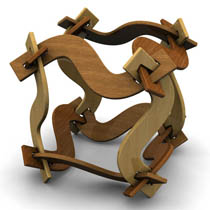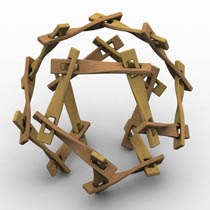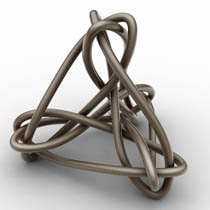6.1. Mirrored Corners. The Borromean Joint can be used to create polyhedral constructions. The first example is the cube. The cube in Figure 45a is made of twelve straight elements with holes at both ends. When you look close you will see that two neighbour connections are each others’ mirror image. When we want to have each of the connections exactly the same we have to use either curved elements (Figure 45b) or bent elements (Figure 45c).



Figure 45a: Borromean Cube.
Figure 45b: Curved elements.
Figure 45c: Twisted elements.




Figure 46: Tetrahedron – curve elements.
Figure 47: Tetrahedron – twisted elements.



Figure 48a: Hamilton path.
Figure 48b: Dodecahedron.
Figure 49: Tr. Icosahedron.



Figure 50: Polyhedron 1.
Figure 51: Polyhedron 2.
Figure 52: Polyhedron 3.



Figure 53a: Single Ring.
Figure 53b: Three Rings.
Figure 53c: Tetrahedron.




Figure 54: Borromean Cube.
Figure 55: Borromean Dodecahedron.
7.1. Conclusion. I think we may say that ‘Through and around weaving’ is as inspiring as ‘Over and under weaving’. Escher did some experiments in this field most probably inspired by the Italian iron window lattices. Nice constructions can be made with this technique especially in combination with the Borromean ring structure.
References
[1] Rinus Roelofs, Het onmogelijke tralieraam, in Pythagoras, 1998.
[2] D. Schattschneider, M. Emmer (Eds.), M.C. Escher’s Legacy, Springer Verlag, 2002.
[3] J.L. Locher, W.F. Veldhuysen, The Magic of M.C. Escher, Thames & Hudson, 2000.